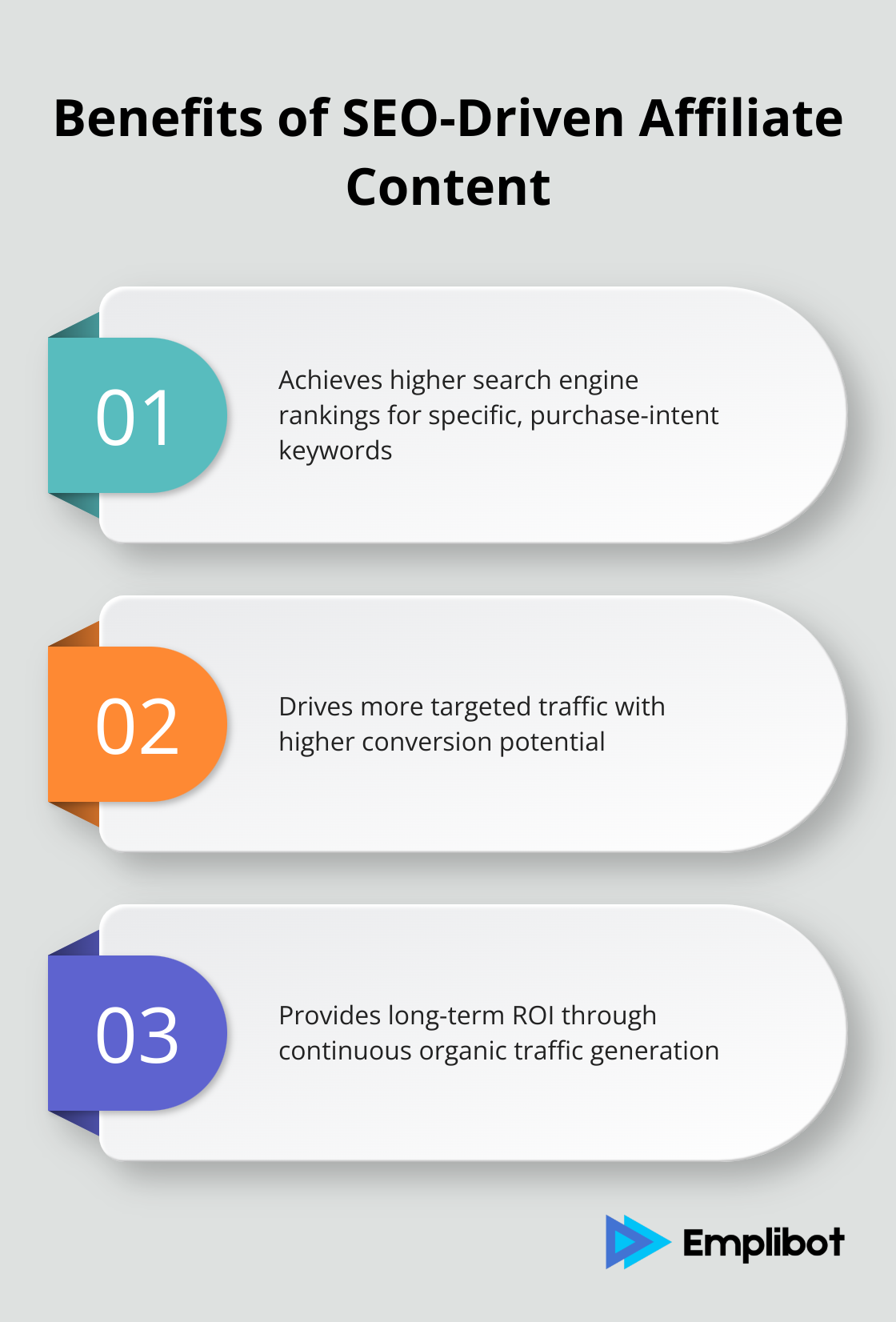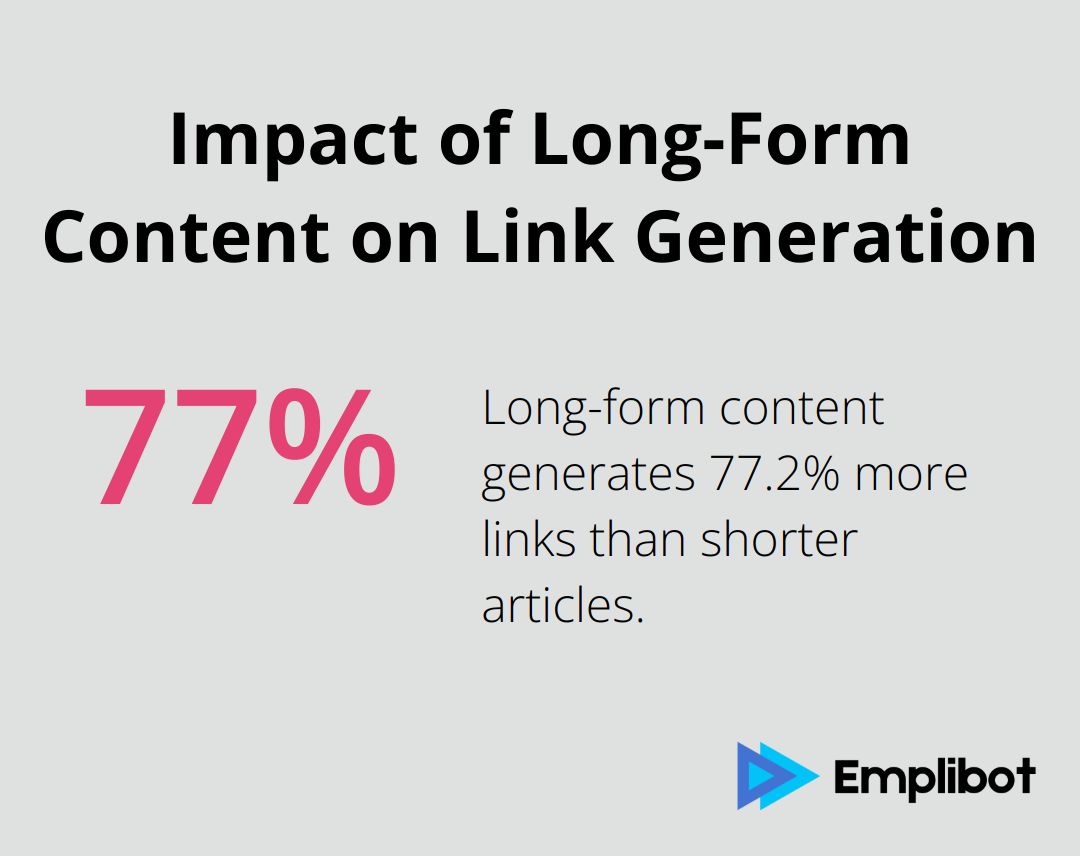At Emplibot, we’ve seen firsthand how powerful the combination of affiliate marketing and SEO can be for online businesses.
Mastering SEO strategies for affiliate content is a game-changer in today’s competitive digital landscape. This approach not only boosts your search rankings but also maximizes your earning potential.
In this post, we’ll show you how to create affiliate content that dominates search results and drives conversions.
Contents
ToggleWhat Is Affiliate Content and Why Does It Matter for SEO?
Defining Affiliate Content
Affiliate content combines product promotion with valuable information for readers. It includes special tracking links that allow creators to earn commissions when their audience makes purchases through those links. However, effective affiliate content goes beyond simply inserting links into a blog post.
The Powerful Synergy of Affiliate Content and SEO
High-quality affiliate content can significantly enhance your SEO efforts. Search engines prioritize informative content that answers users’ questions. When you create comprehensive product reviews, comparison guides, and how-to articles that naturally incorporate affiliate links, you build a resource that search engines want to rank highly.
Leveraging the SEO Advantage of Affiliate Content
Affiliate content provides a unique edge in SEO. It allows you to target specific, purchase-intent keywords that often face less competition than broader terms. For instance, a review of “best budget laptops for students” will likely rank more easily than a generic page about laptops. This targeted approach can lead to higher rankings and more qualified traffic.

Maximizing ROI Through Strategic Content Creation
The combination of affiliate marketing with SEO offers high ROI potential. Unlike paid advertising (which requires constant investment to maintain visibility), SEO-optimized affiliate content can continue to drive traffic and generate income long after publication. Once you rank, organic traffic is free, unlike PPC, which requires ongoing spending.
The Transformative Power of SEO-Driven Affiliate Content
Businesses can transform their online presence by focusing on SEO-driven affiliate content. For example, a study reviewing SEO results from 3 different websites in totally different niches showed significant improvements in their conversion metrics. They focused on creating comprehensive buying guides and product comparisons, which not only ranked well but also converted at a higher rate than their previous content.
To dominate SEO rankings with affiliate content, you must approach it strategically. This involves conducting thorough keyword research, understanding your audience’s needs, and creating content that genuinely adds value. The goal extends beyond product promotion; it’s about becoming a trusted resource in your niche.
Now that we understand the importance of affiliate content for SEO, let’s explore how to craft high-quality content that will boost your search rankings and drive conversions.
How to Create Winning Affiliate Content
Target Your Keyword Research
The foundation of successful affiliate content lies in thorough keyword research. Focus on long-tail keywords that indicate purchase intent. These specific phrases often contain three or more words, target niche audiences, and typically have lower search volumes but higher conversion potential.
Use tools like Ahrefs or SEMrush to identify keywords with a good balance of search volume and difficulty. Look for terms that your competitors might have overlooked. Pay attention to the “People Also Ask” sections in Google search results for additional content ideas.
Craft In-Depth, Value-Packed Content
After you identify your target keywords, create content that truly serves your audience. Go beyond surface-level information. If you write a product review, use the product and provide detailed insights. Share personal experiences, highlight pros and cons, and address common user concerns.
For comparison articles, create comprehensive tables that allow readers to easily compare features across multiple products. Include pricing information, key specifications, and your expert recommendations. This level of detail not only helps with SEO but also builds trust with your audience.
Optimize for Search Engines and Users
While you create your content, keep both search engines and users in mind. Structure your articles with clear headings and subheadings. Use your target keyword naturally throughout the content, including in the title, first paragraph, and at least one subheading.
Incorporate relevant images and videos to enhance user experience. Add alt text to images, using descriptive keywords where appropriate. Consider creating custom graphics or infographics to make your content more shareable and visually appealing.
Balance Promotion with Information
The key to successful affiliate content is to strike the right balance between promotional elements and valuable information. Your primary goal should be to help your readers make informed decisions. Be transparent about your affiliate relationships, but don’t let them overshadow the quality of your content.
Integrate affiliate links naturally within your content. Instead of simply saying “buy this product,” provide context for why you recommend it. For example, “After testing dozens of running shoes, I found that the XYZ model offers the best support for flat feet while staying under $100.”
The most effective affiliate content doesn’t feel like a sales pitch. It feels like helpful advice from a knowledgeable friend. Focus on creating genuine value for your readers, and you’ll not only improve your SEO rankings but also build a loyal audience that trusts your recommendations.
Now that you understand how to create winning affiliate content, let’s explore advanced SEO techniques to further boost your rankings and visibility.
Advanced SEO Tactics for Affiliate Content
Optimize On-Page Elements
Fine-tune your on-page SEO to outperform competitors. Use your primary keyword in the first 100 words of your content and include related keywords throughout. Optimize your title tags and meta descriptions with target keywords to entice clicks. A study by Backlinko found that pages with exact keyword matches in their title tag rank 1.5 positions higher on average.
Make your content scannable with descriptive subheadings (H2s and H3s) that include relevant keywords. Use internal linking to connect your affiliate content with other relevant pages on your site. This helps search engines understand the context and importance of your content.
Build High-Quality Backlinks
Backlinks remain a crucial ranking factor. Focus on earning links from authoritative sites in your niche. Reach out to industry influencers and offer to collaborate on content. Guest posting on reputable sites can also help you build valuable backlinks.
Create linkable assets such as original research, infographics, or comprehensive guides related to your affiliate products. These types of content naturally attract backlinks. For example, long-form content generates 77.2% more links than shorter articles.

Implement Schema Markup
Schema markup helps search engines understand your content better, potentially leading to rich snippets in search results. For affiliate content, use Product schema to highlight key information (like prices, ratings, and availability). According to Search Engine Journal, pages with schema markup rank an average of four positions higher than those without.
Use Review schema for product reviews to display star ratings in search results, which can significantly increase click-through rates. Tools like Google’s Structured Data Markup Helper can assist you in implementing schema correctly.
Boost Site Speed and User Experience
Site speed is a critical ranking factor, especially for mobile searches. Optimize your images, minify CSS and JavaScript, and leverage browser caching to improve load times. Google reports that as page load time increases from 1 to 3 seconds, the probability of bounce increases by 32%.

Create a seamless user experience. Ensure your site is mobile-friendly and easy to navigate. Use clear calls-to-action and make it easy for users to find and purchase the products you promote. A positive user experience not only helps with SEO but also increases the likelihood of conversions.
Monitor and Adapt
SEO is an ongoing process. Continuously monitor your performance and refine your strategies to stay ahead of the competition. Try to adapt to algorithm changes quickly and efficiently. Use tools (such as Google Analytics and Search Console) to track your progress and identify areas for improvement. Advanced platforms now handle the entire content creation process for WordPress blogs, from keyword research to SEO optimization.
Final Thoughts
Dominating SEO rankings with affiliate content can transform your online presence and boost revenue. High-quality, informative content that incorporates affiliate links naturally attracts organic traffic, builds trust, and increases conversions. Success in affiliate SEO requires a sustainable, long-term strategy that delivers consistent results.
The integration of SEO and affiliate marketing creates assets that generate passive income for years. Unlike paid advertising, SEO-optimized affiliate content continues to work long after publication. Implementing SEO strategies (such as keyword research, comprehensive content creation, and on-page optimization) will help your content climb search rankings.
Tools like Emplibot can streamline content creation and SEO efforts for WordPress blogs. Emplibot automates the entire process, allowing you to focus on strategy and growth. Start implementing these tactics today and watch your affiliate content drive more traffic and sales to your business.


![AI Marketing: Lead Generation [Guide]](https://wp.emplibot.com/wp-content/uploads/emplibot/ai-marketing-lead-generation-1753859292-768x456.jpeg)
![AI Marketing: Predictive Lead Scoring [Guide]](https://wp.emplibot.com/wp-content/uploads/emplibot/predictive-lead-scoring-1753772819-768x456.jpeg)

![Google Autocomplete for Keyword Research [Guide]](https://wp.emplibot.com/wp-content/uploads/emplibot/google-autocomplete-for-keyword-research-1753600089-768x456.jpeg)




